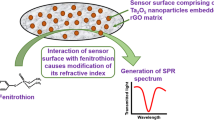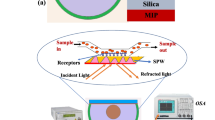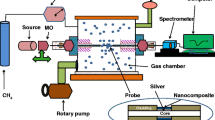Abstract
Precise detection of volatile organic compounds (VOCs) using high-sensitivity fiber-optic probes is highly desirable for rapid screening in the fields of medicine and food processing. A novel spectral surface plasmon resonance (SPR)–based fiber-optic sensor incorporating metal/graphene/Ti3C2Tx MXene layers for the detection of VOCs such as acetone and ethanol is proposed in this study. For the detection of acetone, optimum sensitivities of 5150, 4500, and 4200 nm/refractive index unit (RIU) are obtained using simulations, for sensors with Au, Ag, and Al, respectively, as metal layer. The highest sensitivity achieved at reasonably good detection accuracy is 19,750 nm/RIU, using a Au/graphene/Ti3C2Tx sensor, for VOCs with refractive index 1.434.

Graphical Abstract





Similar content being viewed by others
References
Dong D, Jiao L, Li C, Zhao C (2019) Rapid and real-time analysis of volatile compounds released from food using infrared and laser spectroscopy. TrAC Trends Anal Chem 110:410–416
Popov TA (2011) Human exhaled breath analysis. Ann Allergy Asthma Immunol 106:451–456
Galassetti PR, Novak B, Nemet D, Rose-Gottron C, Cooper DM, Meinardi S, Newcomb R, Zaldivar F, Blake DR (2005) Breath ethanol and acetone as indicators of serum glucose levels: an initial report. Diabetes Technol Ther 7:115–123
Ruzsányi V, Péter Kalapos M (2017) Breath acetone as a potential marker in clinical practice. J Breath Res 11:024002
Nardi-Agmon I, Peled N (2017) Exhaled breath analysis for the early detection of lung cancer: recent developments and future prospects. Lung Cancer (Auckland, NZ) 8:31–38
Gruber B, Keller S, Groeger T, Matuschek G, Szymczak W, Zimmermann R (2016) Breath gas monitoring during a glucose challenge by a combined PTR-QMS/GC×GC-TOFMS approach for the verification of potential volatile biomarkers. J Breath Res 10:036003
Tanda N, Hinokio Y, Washio J, Takahashi N, Koseki T (2014) Analysis of ketone bodies in exhaled breath and blood of ten healthy Japanese at OGTT using a portable gas chromatograph. J Breath Res 8:046008
Righettoni M, Schmid A, Amann A, Pratsinis SE (2013) Correlations between blood glucose and breath components from portable gas sensors and PTR-TOF-MS. J Breath Res 7:037110
Phan N-T, Kim K-H, Jeon E-C, Kim U-H, Sohn JR, Pandey SK (2012) Analysis of volatile organic compounds released during food decaying processes. Environ Monit Assess 184:1683–1692
Jiao L, Guo Y, Chen J, Zhao X, Dong D (2019) Detecting volatile compounds in food by open-path Fourier-transform infrared spectroscopy. Food Res Int 119:968–973
Kim SJ, Koh H-J, Ren CE, Kwon O, Maleski K, Cho S-Y, Anasori B, Kim C-K, Choi Y-K, Kim J, Gogotsi Y, Jung H-T (2018) Metallic Ti3C2Tx MXene gas sensors with ultrahigh signal-to-noise ratio. ACS Nano 12:986–993
Andre RS, Sanfelice RC, Pavinatto A, Mattoso LHC, Correa DS (2018) Hybrid nanomaterials designed for volatile organic compounds sensors: a review. Mater Des 156:154–166
Pang J, Mendes RG, Bachmatiuk A, Zhao L, Ta HQ, Gemming T, Liu H, Liu Z, Rummeli MH (2019) Applications of 2D MXenes in energy conversion and storage systems. Chem Soc Rev 48:72–133
Anasori B, Lukatskaya MR, Gogotsi Y (2017) 2D metal carbides and nitrides (MXenes) for energy storage. Nat Rev Mater 2:16098
Tang H, Hu Q, Zheng M, Chi Y, Qin X, Pang H, Xu Q (2018) MXene–2D layered electrode materials for energy storage. Prog Nat Sci Mater Int 28:133–147
Hantanasirisakul K, Zhao M-Q, Urbankowski P, Halim J, Anasori B, Kota S, Ren CE, Barsoum MW, Gogotsi Y (2016) Fabrication of Ti3C2Tx MXene transparent thin films with tunable optoelectronic properties. Adv Electron Mater 2:1600050
Khazaei M, Ranjbar A, Arai M, Sasaki T, Yunoki S (2017) Electronic properties and applications of MXenes: a theoretical review. J Mater Chem C 5:2488–2503
Wu L, You Q, Shan Y, Gan S, Zhao Y, Dai X, Xiang Y (2018) Few-layer Ti3C2Tx MXene: a promising surface plasmon resonance biosensing material to enhance the sensitivity. Sensors Actuators B Chem 277:210–215
Sinha A, Dhanjai H, Zhao Y, Huang XL, Chen J, Jain R (2018) MXene: an emerging material for sensing and biosensing. TrAC Trends Anal Chem 105:424–435
Kumar S, Lei Y, Alshareef NH, Quevedo-Lopez MA, Salama KN (2018) Biofunctionalized two-dimensional Ti3C2 MXenes for ultrasensitive detection of cancer biomarker. Biosens Bioelectron 121:243–249
Bai X, Ling C, Shi L, Ouyang Y, Li Q, Wang J (2018) Insight into the catalytic activity of MXenes for hydrogen evolution reaction. Sci Bull 63:1397–1403
Li Z, Wu Y 2D early transition metal carbides (MXenes) for catalysis. Small 0:1804736
Maleski K, Ren CE, Zhao M-Q, Anasori B, Gogotsi Y (2018) Size-dependent physical and electrochemical properties of two-dimensional MXene flakes. ACS Appl Mater Interfaces 10:24491–24498
Zheng J, Diao J, Jin Y, Ding A, Wang B, Wu L, Weng B, Chen J (2018) An inkjet printed Ti3C2-GO electrode for the electrochemical sensing of hydrogen peroxide. J Electrochem Soc 165:B227–B231
Wang F, Yang C, Duan M, Tang Y, Zhu J (2015) TiO2 nanoparticle modified organ-like Ti3C2 MXene nanocomposite encapsulating hemoglobin for a mediator-free biosensor with excellent performances. Biosens Bioelectron 74:1022–1028
Liu F, Zhou A, Chen J, Jia J, Zhou W, Wang L, Hu Q (2017) Preparation of Ti3C2 and Ti2C MXenes by fluoride salts etching and methane adsorptive properties. Appl Surf Sci 416:781–789
Justino CIL, Gomes AR, Freitas AC, Duarte AC, Rocha-Santos TAP (2017) Graphene based sensors and biosensors. TrAC Trends Anal Chem 91:53–66
Nag A, Mitra A, Mukhopadhyay SC (2018) Graphene and its sensor-based applications: a review. Sensors Actuators A Phys 270:177–194
Liu N, Chortos A, Lei T, Jin L, Kim TR, Bae W-G, Zhu C, Wang S, Pfattner R, Chen X, Sinclair R, Bao Z (2017) Ultratransparent and stretchable graphene electrodes. Sci Adv 3:e1700159
Xiao S, Wang T, Liu T, Yan X, Li Z, Xu C (2018) Active modulation of electromagnetically induced transparency analogue in terahertz hybrid metal-graphene metamaterials. Carbon 126:271–278
Liu T, Wang H, Liu Y, Xiao L, Zhou C, Liu Y, Xu C, Xiao S (2018) Independently tunable dual-spectral electromagnetically induced transparency in a terahertz metal–graphene metamaterial. J Phys D Appl Phys 51:415105
Xiao S, Wang T, Jiang X, Yan X, Cheng L, Wang B, Xu C (2017) Strong interaction between graphene layer and Fano resonance in terahertz metamaterials. J Phys D Appl Phys 50:195101
Xiao S, Liu T, Zhou C, Jiang X, Cheng L, Xu C (2019) Tailoring slow light with a metal–graphene hybrid metasurface in the terahertz regime. J Opt Soc Am B 36:E48–E54
Sharma AK, Jha R, Gupta BD (2007) Fiber-optic sensors based on surface plasmon resonance: a comprehensive review. IEEE Sensors J 7:1118–1129
Jorgenson RC, Yee SS (1993) A fiber-optic chemical sensor based on surface plasmon resonance. Sensors Actuators B Chem 12:213–220
Gupta G, Kumar A, Boopathi M, Thavaselvam D, Singh B, Vijayaraghavan R (2011) Rapid and quantitative determination of biological warfare agent Brucella abortus CSP-31 using surface plasmon resonance
Ghosh N, Gupta G, Boopathi M, Pal V, Singh AK, Gopalan N, Goel AK (2013) Surface plasmon resonance biosensor for detection of bacillus anthracis, the causative agent of anthrax from soil samples targeting protective antigen. Indian J Microbiol 53:48–55
Villuendas F, Pelayo J (1990) Optical fibre device for chemical seming based on surface plasmon excitridon. Sensors Actuators A Phys 23:1142–1145
Yuan H, Ji W, Chu S, Qian S, Wang F, Masson J-F, Han X, Peng W (2018) Fiber-optic surface plasmon resonance glucose sensor enhanced with phenylboronic acid modified au nanoparticles. Biosens Bioelectron 117:637–643
Semwal V, Gupta BD (2019) Highly sensitive surface plasmon resonance based fiber optic pH sensor utilizing rGO-Pani nanocomposite prepared by in situ method. Sensors Actuators B Chem 283:632–642
Homola J (1997) On the sensitivity of surface plasmon resonance sensors with spectral interrogation. Sensors Actuators B Chem 41:207–211
Ghatak AK, Thyagarajan K (2006) Introduction to fiber optics. Cambridge University Press, Cambridge
Sharma AK, Gupta BD (2007) On the performance of different bimetallic combinations in surface plasmon resonance based fiber optic sensors. J Appl Phys 101:093111
Ordal MA, Long LL, Bell RJ, Bell SE, Bell RR, Alexander RW, Ward CA (1983) Optical properties of the metals Al, Co, Cu, Au, Fe, Pb, Ni, Pd, Pt, Ag, Ti, and W in the infrared and far infrared. Appl Opt 22:1099–1119
Lambrecht A, Reynaud S (2000) Casimir force between metallic mirrors. Eur Phys J D 8:309–318
Bruna M, Borini S (2009) Optical constants of graphene layers in the visible range. Appl Phys Lett 94:031901
Miranda A, Halim J, Lorke A, Barsoum MW (2017) Rendering Ti3C2Tx (MXene) monolayers visible. Mater Res Lett 5:322–328
Sarika S, Gupta BD (2010) Simulation of a surface plasmon resonance-based fiber-optic sensor for gas sensing in visible range using films of nanocomposites. Meas Sci Technol 21:115202
Hansen WN (1968) Electric fields produced by the propagation of plane coherent electromagnetic radiation in a stratified medium. J Opt Soc Am 58:380–390
Downes F, Taylor CM (2015) Optical fibre surface plasmon resonance sensor based on a palladium-yttrium alloy. Procedia Eng 120:602–605
Mohammadi MD, Hamzehloo M (2019) Densities, viscosities, and refractive indices of binary and ternary mixtures of methanol, acetone, and chloroform at temperatures from (298.15–318.15) K and ambient pressure. Fluid Phase Equilib 483:14–30
Mishra AK, Mishra SK, Verma RK (2016) Graphene and beyond graphene MoS2: a new window in surface-plasmon-resonance-based fiber optic sensing. J Phys Chem C 120:2893–2900
Luo J, Zhang W, Yuan H, Jin C, Zhang L, Huang H, Liang C, Xia Y, Zhang J, Gan Y, Tao X (2017) Pillared structure design of MXene with ultralarge interlayer spacing for high-performance lithium-ion capacitors. ACS Nano 11:2459–2469
Chen H, Kou X, Yang Z, Ni W, Wang J (2008) Shape- and size-dependent refractive index sensitivity of gold nanoparticles. Langmuir 24:5233–5237
Acknowledgments
The authors are thankful to Dr. K. V. Dominic, Professor of English (retired) and Editor-in-Chief, Writers Editors Critics (WEC), Prof. B. Hariharan, Institute of English, University of Kerala, and Thomas Nedumpara, North Cumbria University Hospitals NHS Trust, Carlisle, UK, for the support given in English language editing. Sudheer VR acknowledges the Co-Operative Academy of Professional Education for providing fellowship under the Faculty Development Program
Author information
Authors and Affiliations
Corresponding authors
Ethics declarations
Conflict of Interest
The authors declare that they have no conflict of interest.
Additional information
Publisher’s Note
Springer Nature remains neutral with regard to jurisdictional claims in published maps and institutional affiliations.
Rights and permissions
About this article
Cite this article
Sudheer, V.R., Kumar, S.R.S. & Sankararaman, S. Ultrahigh Sensitivity Surface Plasmon Resonance–Based Fiber-Optic Sensors Using Metal-Graphene Layers with Ti3C2Tx MXene Overlayers. Plasmonics 15, 457–466 (2020). https://doi.org/10.1007/s11468-019-01035-3
Received:
Accepted:
Published:
Issue Date:
DOI: https://doi.org/10.1007/s11468-019-01035-3




